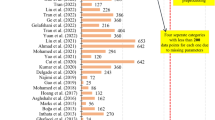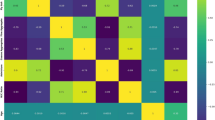Abstract
This study focuses on predicting surface chloride concentration (\({C}_{\mathrm{s}}\)) in marine concrete structures using machine learning (ML) models. The dataset includes input features related to composition and environmental conditions, along with corresponding \({C}_{\mathrm{s}}\) values. Objectives include evaluating ML model performance, investigating the impact of outliers, analyzing feature importance, and proposing an adaptive ensemble model. ML models used are linear regression, support vector machine regression, decision tree regression, random forest regression, gradient boosting regression, XGBoost regression, and multi-layer perceptron regression. The dataset is pre-processed with normalization, outlier handling, and one-hot encoding for categorical features. Models are trained with tenfold cross-validation. Outliers handling has varying effects on model performance. Linear regression, decision tree, and XGBoost models show decreased performance, while support vector machine regression improves performance. Random Forest, gradient boosting, multi-layer perceptron, and the adaptive ensemble model are relatively unaffected. Feature importance analysis reveals varying significance of input features across models. The Adaptive Ensemble model combines predictions from base models using weighted averaging. Weights are assigned based on performance. The proposed ensemble model achieves improved predictive accuracy (around 95%) compared to individual models (best individual model performance around 81%).









Similar content being viewed by others
Data availability
Data will be made available on request.
References
Almuallim, H., Kaneda, S., & Akiba, Y. (2002). Development and Applications of Decision Trees. In Expert Systems (pp. 53–77). https://doi.org/10.1016/b978-012443880-4/50047-8
Benesty, J., Chen, J., Huang, Y., & Cohen, I. (2009). Pearson correlation coefficient. In Springer Topics in Signal Processing (Vol. 2, pp. 1–4). Springer Science and Business Media B.V. https://doi.org/10.1007/978-3-642-00296-0_5
Breiman, L. (2001). Random forests. Machine Learning, 45(1), 5–32. https://doi.org/10.1023/A:1010933404324
Cai, R., Han, T., Liao, W., Huang, J., Li, D., Kumar, A., & Ma, H. (2020a). Prediction of surface chloride concentration of marine concrete using ensemble machine learning. Cement and Concrete Research, 136, 106164. https://doi.org/10.1016/j.cemconres.2020.106164
Cai, R., Hu, Y., Yu, M., Liao, W., Yang, L., Kumar, A., & Ma, H. (2020b). Skin effect of chloride ingress in marine concrete: a review on the convection zone. Construction and Building Materials, 262, 120566. https://doi.org/10.1016/J.CONBUILDMAT.2020.120566
Chalee, W., Jaturapitakkul, C., & Chindaprasirt, P. (2009). Predicting the chloride penetration of fly ash concrete in seawater. Marine Structures, 22(3), 341–353. https://doi.org/10.1016/J.MARSTRUC.2008.12.001
Chen, T., & Guestrin, C. (2016). XGBoost: A scalable tree boosting system. In: Proceedings of the ACM SIGKDD International Conference on Knowledge Discovery and Data Mining, 13–17-August-2016, 785–794. https://doi.org/10.1145/2939672.2939785
Chou, J. S., & Pham, A. D. (2013). Enhanced artificial intelligence for ensemble approach to predicting high performance concrete compressive strength. Construction and Building Materials, 49, 554–563. https://doi.org/10.1016/J.CONBUILDMAT.2013.08.078
Cihan, M. T. (2019). Prediction of concrete compressive strength and slump by machine learning methods. Advances in Civil Engineering. https://doi.org/10.1155/2019/3069046
Cortes, C., & Vapnik, V. (1995). Support-vector networks. Machine Learning, 20(3), 273–297. https://doi.org/10.1007/bf00994018
Costa, A., & Appleton, J. (1999a). Chloride penetration into concrete in marine environment—Part I: Main parameters affecting chloride penetration. Materials and Structures/Materiaux Et Constructions, 32(4), 252–259. https://doi.org/10.1007/BF02479594/METRICS
Costa, A., & Appleton, J. (1999b). Chloride penetration into concrete in marine environment—Part II: Prediction of long term chloride penetration. Materials and Structures/Materiaux Et Constructions, 32(5), 354–359. https://doi.org/10.1007/BF02479627/METRICS
Erdal, H. I., Karakurt, O., & Namli, E. (2013). High performance concrete compressive strength forecasting using ensemble models based on discrete wavelet transform. Engineering Applications of Artificial Intelligence, 26(4), 1246–1254. https://doi.org/10.1016/j.engappai.2012.10.014
Farahani, A., Taghaddos, H., & Shekarchi, M. (2015). Prediction of long-term chloride diffusion in silica fume concrete in a marine environment. Cement and Concrete Composites, 59, 10–17. https://doi.org/10.1016/J.CEMCONCOMP.2015.03.006
Feng, D. C., Liu, Z. T., Wang, X. D., Chen, Y., Chang, J. Q., Wei, D. F., & Jiang, Z. M. (2020). Machine learning-based compressive strength prediction for concrete: An adaptive boosting approach. Construction and Building Materials, 230, 117000. https://doi.org/10.1016/j.conbuildmat.2019.117000
Friedman, J. H. (2001). Greedy function approximation: a gradient boosting machine. Annals of Statistics, 29(5), 1189–1232.
Gao, Y. H., Zhang, J. Z., Zhang, S., Zhang, Y., & rong. (2017). Probability distribution of convection zone depth of chloride in concrete in a marine tidal environment. Construction and Building Materials, 140, 485–495. https://doi.org/10.1016/J.CONBUILDMAT.2017.02.134
Glass, G. K., & Buenfeld, N. R. (2000). The influence of chloride binding on the chloride induced corrosion risk in reinforced concrete. Corrosion Science, 42(2), 329–344. https://doi.org/10.1016/S0010-938X(99)00083-9
Guo, A., Li, H., Ba, X., Guan, X., & Li, H. (2015). Experimental investigation on the cyclic performance of reinforced concrete piers with chloride-induced corrosion in marine environment. Engineering Structures, 105, 1–11. https://doi.org/10.1016/J.ENGSTRUCT.2015.09.031
Han, T., Siddique, A., Khayat, K., Huang, J., & Kumar, A. (2020). An ensemble machine learning approach for prediction and optimization of modulus of elasticity of recycled aggregate concrete. Construction and Building Materials, 244, 118271. https://doi.org/10.1016/J.CONBUILDMAT.2020.118271
Hopfield, & JJ. (1988). Artificial neural networks. IEEE Circuits and Devices Magazine, 4(5), 3–10. https://doi.org/10.1016/B978-0-444-53632-7.01101-1
Kaveh, A., Ahani, M. K., Fahimi, M., Kalateh-Ahani, M., & Fahimi-Farzam, M. (2013). Constructability optimal design of reinforced concrete retaining walls using a multi-objective genetic algorithm. Structural Engineering and Mechanics, 47(2), 227–245. https://doi.org/10.12989/sem.2013.47.2.227
Kaveh, A., DadrasEslamlou, A., Javadi, S. M., & Geran Malek, N. (2021). Machine learning regression approaches for predicting the ultimate buckling load of variable-stiffness composite cylinders. Acta Mechanica, 232(3), 921–931. https://doi.org/10.1007/S00707-020-02878-2/METRICS
Kaveh, A., Fazel-Dehkordi, D., & Servati, H. (2009). Prediction of moment-rotation characteristic for saddle-like connections using FEM and BP neural networks. Computational Engineering Using Metaphors from Nature, 64(3), 15–24. https://doi.org/10.4203/ccp.64.1.3
Kaveh, A., & Khavaninzadeh, N. (2023). Efficient training of two ANNs using four meta-heuristic algorithms for predicting the FRP strength. Structures, 52, 256–272. https://doi.org/10.1016/J.ISTRUC.2023.03.178
Kaveh, A., & Servati, H. (2001). Design of double layer grids using backpropagation neural networks. Computers & Structures, 79(17), 1561–1568. https://doi.org/10.1016/S0045-7949(01)00034-7
Kumar Tipu, R., Panchal, V. R., & Pandya, K. S. (2022). An ensemble approach to improve BPNN model precision for predicting compressive strength of high-performance concrete. Structures, 45, 500–508. https://doi.org/10.1016/J.ISTRUC.2022.09.046
Li, Q. F., & Song, Z. M. (2022). High-performance concrete strength prediction based on ensemble learning. Construction and Building Materials, 324, 126694. https://doi.org/10.1016/J.CONBUILDMAT.2022.126694
Lin, P.-L., & Pelton, A. D. (1977). Analytical solution of Fick’s second law when the diffusion coefficient is a linear function of concentration. Berichte Der Bunsengesellschaft Für Physikalische Chemie, 81(12), 1243–1250. https://doi.org/10.1002/BBPC.19770811210
Liu, Q. F., Iqbal, M. F., Yang, J., Lu, X. Y., Zhang, P., & Rauf, M. (2021). Prediction of chloride diffusivity in concrete using artificial neural network: modelling and performance evaluation. Construction and Building Materials. https://doi.org/10.1016/j.conbuildmat.2020.121082
Luping, T. (2008). Engineering expression of the ClinConc model for prediction of free and total chloride ingress in submerged marine concrete. Cement and Concrete Research, 38(8–9), 1092–1097. https://doi.org/10.1016/J.CEMCONRES.2008.03.008
Marques, P. F., Costa, A., & Lanata, F. (2012). Service life of RC structures: chloride induced corrosion—prescriptive versus performance-based methodologies. Materials and Structures/Materiaux Et Constructions, 45(1–2), 277–296. https://doi.org/10.1617/S11527-011-9765-2/METRICS
Meira, G. R., Andrade, C., Alonso, C., Borba, J. C., & Padilha, M. (2010). Durability of concrete structures in marine atmosphere zones—The use of chloride deposition rate on the wet candle as an environmental indicator. Cement and Concrete Composites, 32(6), 427–435. https://doi.org/10.1016/J.CEMCONCOMP.2010.03.002
Mohamed, O., Kewalramani, M., Ati, M., & Hawat, W. A. (2021). Application of ANN for prediction of chloride penetration resistance and concrete compressive strength. Materialia, 17, 101123. https://doi.org/10.1016/j.mtla.2021.101123
Montemor, M. F., Simões, A. M. P., & Ferreira, M. G. S. (2003). Chloride-induced corrosion on reinforcing steel: From the fundamentals to the monitoring techniques. Cement and Concrete Composites, 25(4–5), 491–502. https://doi.org/10.1016/S0958-9465(02)00089-6
Nagelkerke, N. J. D. (1991). A note on a general definition of the coefficient of determination. Biometrika, 78(3), 691–692. https://doi.org/10.1093/biomet/78.3.691
Nguyen, H., Vu, T., Vo, T. P., & Thai, H. T. (2021). Efficient machine learning models for prediction of concrete strengths. Construction and Building Materials, 266, 120950. https://doi.org/10.1016/J.CONBUILDMAT.2020.120950
Nunez, I., & Nehdi, M. L. (2021). Machine learning prediction of carbonation depth in recycled aggregate concrete incorporating SCMs. Construction and Building Materials, 287, 123027. https://doi.org/10.1016/j.conbuildmat.2021.123027
Pack, S. W., Jung, M. S., Song, H. W., Kim, S. H., & Ann, K. Y. (2010). Prediction of time dependent chloride transport in concrete structures exposed to a marine environment. Cement and Concrete Research, 40(2), 302–312. https://doi.org/10.1016/J.CEMCONRES.2009.09.023
Pelton, A. D., & Etsell, T. H. (1972). Analytical solution of Fick’s second law when the diffusion coefficient varies directly as concentration. Acta Metallurgica, 20(11), 1269–1274. https://doi.org/10.1016/0001-6160(72)90057-0
Rofooei, F. R., Kaveh, A., & Farahani, F. M. (2011). Estimating the vulnerability of the concrete moment resisting frame structures using artificial neural networks. International Journal of Optimization in Civil Engineering, 1(3), 433–448. http://ijoce.iust.ac.ir/article-1-49-en.html. Accessed 8 Apr 2023
Safehian, M., & Ramezanianpour, A. A. (2013). Assessment of service life models for determination of chloride penetration into silica fume concrete in the severe marine environmental condition. Construction and Building Materials, 48, 287–294. https://doi.org/10.1016/J.CONBUILDMAT.2013.07.006
Safehian, M., & Ramezanianpour, A. A. (2015). Prediction of RC structure service life from field long term chloride diffusion. Computers and Concrete, 15(4), 589–606. https://doi.org/10.12989/CAC.2015.15.4.589
Sargam, Y., Wang, K., & Cho, I. H. (2021). Machine learning based prediction model for thermal conductivity of concrete. Journal of Building Engineering, 34(October), 101956. https://doi.org/10.1016/j.jobe.2020.101956
Shah, M. I., Memon, S. A., Khan Niazi, M. S., Amin, M. N., Aslam, F., & Javed, M. F. (2021). Machine learning-based modeling with optimization algorithm for predicting mechanical properties of sustainable concrete. Advances in Civil Engineering. https://doi.org/10.1155/2021/6682283
Shariati, M., Mafipour, M. S., Ghahremani, B., Azarhomayun, F., Ahmadi, M., Trung, N. T., & Shariati, A. (2022). A novel hybrid extreme learning machine–grey wolf optimizer (ELM-GWO) model to predict compressive strength of concrete with partial replacements for cement. Engineering with Computers, 38(1), 757–779. https://doi.org/10.1007/S00366-020-01081-0/TABLES/7
Tipu, R. K., Panchal, V. R., & Pandya, K. S. (2022). Prediction of concrete properties using machine learning algorithm. Journal of Physics: Conference Series, 2273(1), 012016. https://doi.org/10.1088/1742-6596/2273/1/012016
Wang, Y., Liu, Z., Fu, K., Li, Q., & Wang, Y. (2020). Experimental studies on the chloride ion permeability of concrete considering the effect of freeze–thaw damage. Construction and Building Materials, 236, 117556. https://doi.org/10.1016/J.CONBUILDMAT.2019.117556
Wang, Y., Wu, L., Wang, Y., Li, Q., & Xiao, Z. (2018). Prediction model of long-term chloride diffusion into plain concrete considering the effect of the heterogeneity of materials exposed to marine tidal zone. Construction and Building Materials, 159, 297–315. https://doi.org/10.1016/J.CONBUILDMAT.2017.10.083
Yang, L. F., Cai, R., & Yu, B. (2017). Investigation of computational model for surface chloride concentration of concrete in marine atmosphere zone. Ocean Engineering, 138, 105–111. https://doi.org/10.1016/J.OCEANENG.2017.04.024
Yang, L. F., Cai, R., & Yu, B. (2018). Modeling of environmental action for submerged marine concrete in terms of surface chloride concentration. Structural Concrete, 19(5), 1512–1520. https://doi.org/10.1002/SUCO.201800072
Zhang, J., Zhao, J., Zhang, Y., Gao, Y., & Zheng, Y. (2018). Instantaneous chloride diffusion coefficient and its time dependency of concrete exposed to a marine tidal environment. Construction and Building Materials, 167, 225–234. https://doi.org/10.1016/J.CONBUILDMAT.2018.01.107
Ziolkowski, P., & Niedostatkiewicz, M. (2019). Machine learning techniques in concrete mix design. Materials. https://doi.org/10.3390/ma12081256
Zuquan, J., Xia, Z., Tiejun, Z., & Jianqing, L. (2018). Chloride ions transportation behavior and binding capacity of concrete exposed to different marine corrosion zones. Construction and Building Materials, 177, 170–183. https://doi.org/10.1016/J.CONBUILDMAT.2018.05.120
Funding
No funding is received for this study.
Author information
Authors and Affiliations
Contributions
RKT contributed to the conceptualization of the study, conducted investigations, developed the methodology, generated ideas, performed software coding, validated the results, and contributed to the writing of the original draft. Suman, Vandna Batra, VRP, and KSP contributed to the review and editing of the manuscript. All authors reviewed the manuscript.
Corresponding author
Ethics declarations
Conflict of interest
The authors declares that they have no known competing financial interest or personal relationship that could have appear to influence the work reported in this paper.
Additional information
Publisher's Note
Springer Nature remains neutral with regard to jurisdictional claims in published maps and institutional affiliations.
Rights and permissions
Springer Nature or its licensor (e.g. a society or other partner) holds exclusive rights to this article under a publishing agreement with the author(s) or other rightsholder(s); author self-archiving of the accepted manuscript version of this article is solely governed by the terms of such publishing agreement and applicable law.
About this article
Cite this article
Tipu, R.K., Batra, V., Suman et al. Predictive modelling of surface chloride concentration in marine concrete structures: a comparative analysis of machine learning approaches. Asian J Civ Eng 25, 1443–1465 (2024). https://doi.org/10.1007/s42107-023-00854-4
Received:
Accepted:
Published:
Issue Date:
DOI: https://doi.org/10.1007/s42107-023-00854-4




